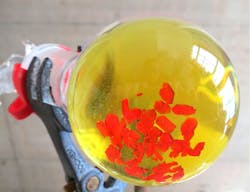Molecular thermometer allows contactless measurement using infrared light
| Thermo-chromium in a solid (red) and dissolved (yellow) state can be used for contactless measurement of temperature. (Photo: Sven Otto) |
Chemists at Johannes Gutenberg University Mainz (JGU; Mainz, Germany)) in cooperation with researchers of the German Federal Institute for Materials Research and Testing (BAM; Berlin, Germany) have developed a molecular thermometer. Developed by a team headed by professor Katja Heinze at the JGU Institute of Inorganic Chemistry and Analytical Chemistry, the thermometer is actually a water-soluble molecule containing the element chromium, giving it a red color.1 The researchers call it "thermo-chromium."
This molecule can be used to measure temperature in many different environments thanks to its solubility: it can be introduced into liquids, solids, nanoparticles, and micelles. Thus, it has potential applications in the fields of the material sciences, biology, and medicine.
Measuring the temperature with thermo-chromium is straightforward. The relevant site is irradiated with blue light that is absorbed by the molecule, which then emits infrared radiation at two different wavelengths. Depending on the temperature, there is more intense emission of infrared at one of the two wavelengths. The temperature is then determined on the basis of the ratio of intensity of the two wavelengths. "Anyone with a simple emission spectrometer can undertake this kind of measurement," says Sven Otto, a doctoral candidate in Heinze's team. "The molecular ruby works at 100°C just as well as at -63°C; that is in a range relevant to everyday practice," he says.
The principle of optical ratiometric temperature measurement is not new. However, it was previously impossible to take measurements using only a single type of photoactive agent. To date, scientists always needed two dyes: one that produced emission dependent on temperature, and another reference dye with emission independent of temperature. That made synthesis and calibration a lot more difficult.
"Our molecular ruby, on the other hand, is simply made from inexpensive raw materials and no additional reference substances are required to measure temperature," says Heinze. "It can be employed whenever we want to measure temperature without having to contact the object directly as with a conventional thermometer."
Source: http://www.uni-mainz.de/presse/aktuell/1802_ENG_HTML.php
REFERENCE:
1. Sven Otto et al., Chemistry--A European Journal (2017); doi: 10.1002/chem.201701726
